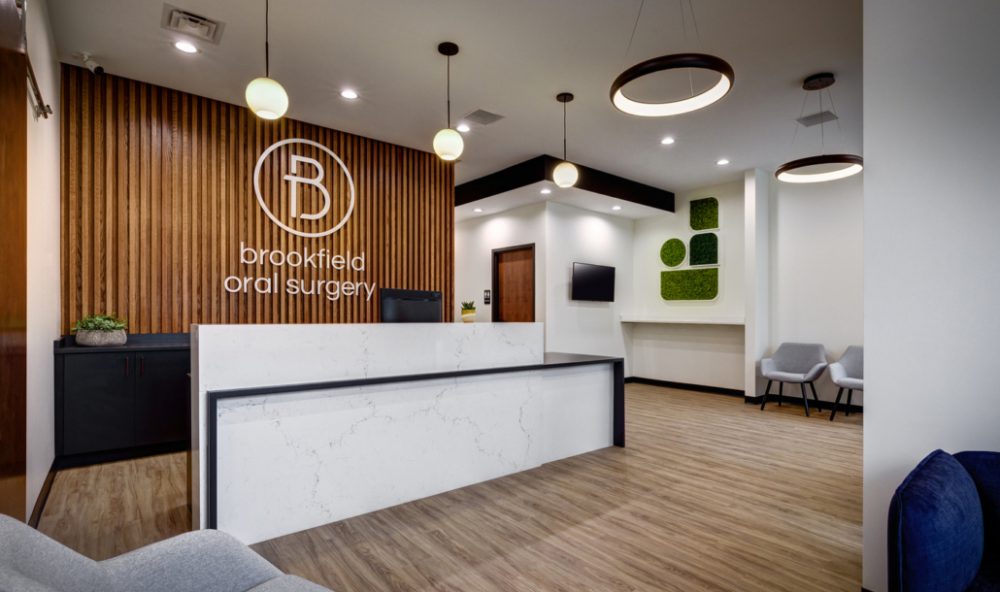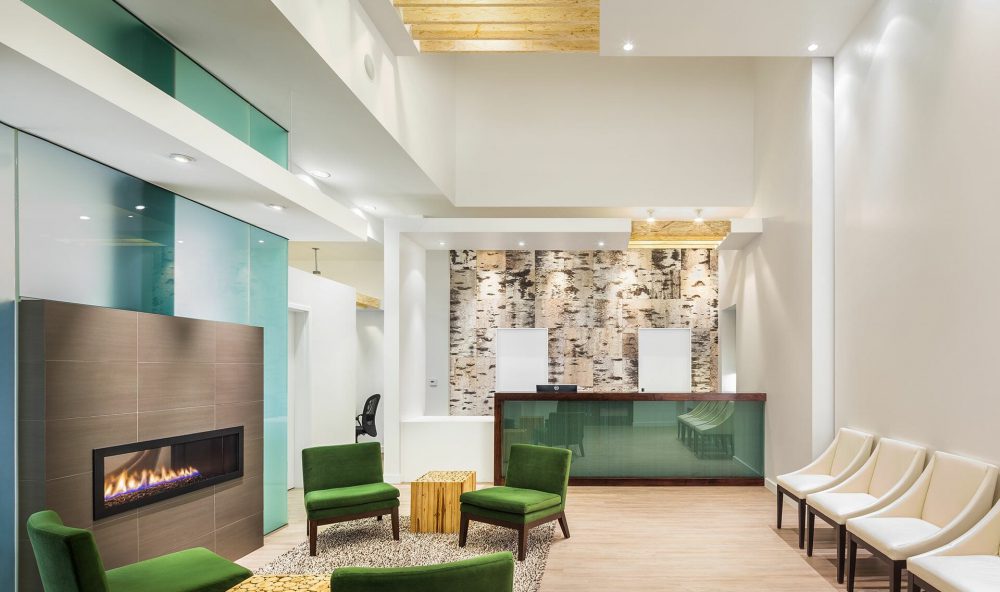
Image Source: Apex Design Build
Dental Economics (DE) recently wrote about the importance of a welcoming dental practice environment and how it plays a key role in attracting new patients and increasing practice profitability. “A well-conceived design,” writes DE, “enhances your professional image, makes your practice more efficient, improves productivity, and ultimately builds profitability.”
How does dental practice design accomplish all this?
Physical elements of dental practice design like waiting-room furniture, front-office layout, and other elements of a dental practice environment are certainly significant to practice growth because they create and leave a lasting client impression, which factors into what potential clients hear about a practice through online dental reviews or word of mouth. Yet dental practice design involves more than appealing dental office aesthetics. It involves the experience patients have with your staff and technology and other dental practice operational elements to help practices operate more efficiently while effectively serving patient care—a quality of the dental practice environment called “functional balance” in a recent article by the American Dental Association (ADA).
“For enhanced functionality,” writes the ADA, “balance is key. Your design should serve for [patient] aesthetics but also keeping your employees in mind.” Adding that dentists should ideally involve staff input when rethinking the dental practice environment, the ADA article includes technology and other dental practice operational elements as part of dental practice design for a dental practice environment that creates both an engaging client experience and more efficient environment for staff, which promotes productivity and job satisfaction.
To help your practice with all this, this article covers:
· How a welcoming dental practice environment specifically helps create patient satisfaction.
· Crafting a comfortable physical environment in your dental practice.
· Building the behavioral aspects of a welcoming dental practice.
· Leveraging technology for a better dental practice environment
Let’s dive it.
How a Welcoming Dental Practice Environment Specifically Helps Create Patient Satisfaction

Image Source: Dental Ease
The Dental Office Atmosphere Helps Address Dental Anxiety
As a leading cause of missed dental appointments, long re-care intervals, and incomplete or interrupted treatment plans, dental anxiety—ranging from mild to severe for anywhere between 50% and 80% of U.S. adults—involves a range of causes that fall under five common themes, according to a recent study published in the Journal of Dental Hygiene (JDH):
· Fear of the dental experience
· Previous negative dental experience
· Cost of treatment
· Gag reflex
· Fear of bad news
“When patients are afraid,” write the co-authors of a recent dental anxiety article in Dimensions of Dental Hygiene, “they avoid environments and tasks that stimulate those negative feeling.” When practices create a positive patient experience through dental practice design, they naturally help reduce dental anxiety and missed appointments to ensure better practice profitability and patient oral health, and creating a positive dental practice environment doesn’t necessarily mean spending large for an extensive architectural makeover.
In a recent Dentistry IQ article, for example, dental consultant and practice owner Jessica Martin notes how sensory triggers like the noise of dental tools, smells, and seeing patients exit appointments in pain can trigger dental anxiety. So, simply ensuring patients don’t hear certain sounds and making any necessary adjustments to how patients walk in and out of your practice can go far in reducing dental anxiety. “If a dental team can reduce these sensory assaults,” writes Martin, “patients will be able to make more positive judgments about their experience,” which helps build patient trust, increase willingness to accept maintenance recommendations, and improve commitment to keeping appointments. “This,” adds Martin, “has a huge impact on the bottom line of any dental practice.”
Other low-cost ways practices use for reducing dental anxiety and improving dental patient satisfaction:
· Calming music played through the dental office or headphones worn by patients.
· Television monitors installed above dental chairs to relax and distract patients during checkups and procedures.
· Convenient parking to reduce patient stress before they walk through the door.
Dental Practice Design Must Include Your Digital Presence
To attract more patients, dental practice design must extend beyond the physical elements that patients see and the experiences they have when they visit your practice.
Those things are certainly key to satisfaction and loyalty among people who are already patients. Yet most potential patients aren’t in the habit pf physically walking into a dental practice to form an impression and decide whether to become a patient. Most potential patients (if not all) are going to search online for a local dentist and, depending on what they come across connected to your digital presence, you’ll either win their trust and or give them cause to continue searching.
To avoid the latter, your dental practice’s digital presence should be part of dental practice design and serve as a congruent extension of the dental practice environment you’ve created, why patients choose your practice, and what potential patients can expect when they walk in. All this helps address dental anxiety, build trust, and attract more patients.
Your dental website is the most obvious starting point.
Your dental practice environment may be the kind of place where patients feel at ease. Yet if your dental practice website does not reflect your dental practice environment, potential patients may draw the wrong conclusions about what they can expect to find.
So, make sure your dental website not only provides a great user experience with elements like easy, intuitive navigation but reflects and showcases your dental practice environment, meaning the reason patients choose your practice and why website visitors should make the same choice. A few tips:
· Express your personality with a website loaded with interactive, lead-capturing features.
· Make sure web pages are clean, modern, and captivating.
· Provide content that helps alleviate dental anxiety by explaining what your practice does and who your staff are and provide photos to help potential patients visualize your work and see the end results.
>> Here are example dental websites to show you what the above look like.
Patient reviews also illustrate the importance of digital presence in dental practice design.
Though word of mouth will always be valuable to dental practices, a recent survey by IronMonk shows 43.3% of Americans age 18 to 65+ choose a local dentist based on the best online reviews, which explains key findings in ProSites’ 2023 State of Dental Marketing Report (free to download here):
· 27% of dental practices are planning to cultivate more online patient reviews.
· Only 25% of practices in 2023 considered word of mouth to be most important in dental marketing, versus 80% in 2022.
So, when inviting patients to provide reviews of your practice, formulate questions that ask why they enjoy visiting your practice.
Reviews such as “This is the best practice” are certainly great but when patients talk about specifics such as elements in place to help reduce dental anxiety or how your staff delivers a superior patient experience, they give potential patients focused feedback that addresses specific elements of dental anxiety and encourages them to approach your practice, and yes. Managing patient reviews can seem like a lot, but here’s how dental practices easily stay on top of patient reviews.
Crafting a Comfortable Dental Practice Environment

Image Source: Decorilla
Once patients walk into your dental practice, you naturally want to ensure they’re walking into a dental practice environment that strengthens their trust, puts them at ease, and keeps them coming back. To do this, creating a comfortable dental practice environment involves two main aspects:
· The design and décor of your dental practice building
· How patients perceive such elements
Though dental practice designs can differ based on personal taste, budget, and physical space limitations, three basics in dental office aesthetics will always be fundamental in creating a welcoming physical environment:
1. Comfort
Patients will always appreciate comfort and accommodation when waiting for an appointment. Central to this are comfortable waiting room chairs, things to keep pass the time (e.g., magazines) and accommodations like play areas for patients who arrive with children). Soft lighting and the artwork you choose also add to a comfortable and soothing dental office atmosphere for patients.
2. Color
How important is color in dental practice design and décor? “It’s very important,” writes the ADA. “Whether you are remodeling your existing practice or opening a new one, choosing the right color design can have a positive effect.” Yet color also comes with possible drawbacks because color affects perceptions.
The ADA uses white as an example. Though white is typically associated with cleanliness and purity (two things that practices undoubtedly want patients to feel when entering a practice), white can also feel clinical and off-putting. As such, the ADA recommends white as a base or accent color.
For a complete breakdown of colors and their associated psychology, read the ADA article “The Perfect Relaxing Colors to Feature in Your Office.”
3. Cleanliness
Though dental practices understand the importance of hygiene and cleanliness in maintaining a safe and healthy dental practice environment for patients and staff, they’re also important in ensuring optimal patient comfort levels.
A well-maintained and hygienic dental office atmosphere instills confidence in patients and helps alleviate any apprehensions they may have about visiting a practice. Clean and sterilized dental instruments and treatment rooms create a sense of trust and safety. Additionally, pristine dental office aesthetics, including a tidy waiting area and spotless facilities, contribute to a positive first impression, making patients feel more at ease from the moment they step into a practice.
By prioritizing dental practice hygiene and cleanliness, dental professionals not only promote patient comfort but also establish a reputation for excellence and professionalism, further solidifying patient trust and loyalty.
Building the Behavioral Aspects of a Welcoming Dental Practice

Creating a welcoming dental practice environment for patients includes the experience patients have with staff, and staff empathy and effective patient communications are cornerstone to an experience that keeps patients coming back and reviews that attract more patients.
Staff Empathy
Empathy is foundational to compassionate care as it allows dental professionals to understand and connect with patients on a deeper level, acknowledging their fears and concerns. By demonstrating genuine concern and compassion, dental staff can alleviate anxiety and instill trust in patients, making them more likely to accept recommendations and treatments.
“Research indicates that ‘soft skills’ have a direct bearing on patient perceptions of the value of care provided,” writes the Nova Scotia Dental Association, “the degree of trust placed in the dentist, and the success of treatment.” Echoing this, this NE Dental Academy recently wrote, “Many patients struggle with dental anxiety,” and empathy for patients “will help them stay calm and be open to treatment recommendations and other feedback you have for them.”
Effective Patient Communications
Effective patient communication fosters clear and transparent exchanges between your dental team and patients. By actively listening to your patients’ needs, addressing their questions, and explaining procedures in a patient-friendly manner, your dental staff ensures patients feel heard, valued, and involved in their own care.
A practice that prioritizes empathy and effective communication nurtures a sense of comfort and safety, encouraging patients to become loyal and enthusiastic practice advocates, which contributes to practice growth and success.
Effective patient communications also involve having an efficient system in place like automated appointment reminders to save staff time while ensuring patients receive timely and relevant communications to reduce no-shows and keep patients engaged between appointments.
Staff Training and Behavior: Boosting Effective Communication in Dentistry
Effective communication in dentistry plays a pivotal role in fostering positive patient experiences and building lasting relationships. To achieve this, dental staff training becomes an indispensable component.
Through comprehensive training programs, dental professionals can develop essential communication skills, including active listening, empathy, and clear articulation of treatment options and procedures. Such training equips the staff to navigate sensitive discussions with patients, addressing their anxieties and concerns with compassion and understanding. By continually honing their communication abilities, dental staff can establish a welcoming and supportive atmosphere, putting patients at ease and earning their trust. Ultimately, investing in dental staff training for effective patient communications cultivates a patient-centric practice that not only boosts patient satisfaction but also strengthens the reputation and success of the dental clinic.
Enhancing Patient Engagement in Dental Practices
Patient engagement in dental practices is a crucial aspect of enhancing the dental patient experience and promoting better oral health outcomes. Establishing effective communication channels with patients ensures that they are actively involved in their dental care journey, making informed decisions about their oral health. Creating a welcoming and supportive dental practice environment where patients feel comfortable asking questions and expressing their concerns fosters this engagement.
To best educate patients about their dental health, dental professionals should employ clear and jargon-free language to explain dental procedures and treatment options. Utilizing visual aids, such as images and models, can further enhance patient understanding. Additionally, personalized oral health education plans tailored to each patient’s specific needs can empower them to take an active role in maintaining their dental well-being.
By prioritizing patient engagement and education, dental practices can cultivate long-lasting patient relationships and improve overall oral health outcomes.
Personalization and Its Role in Dental Practice Customer Service
Personalized dental care has a profound impact on dental patient satisfaction. When patients feel seen and heard, they develop a stronger sense of trust and connection with their dental providers, leading to a more positive overall dental practice customer service experience.
To improve patient service through personalized care, dental staff can implement a few key recommendations.
· First, actively listen and engage with patients during appointments, taking note of personal details and dental history in their records. Using these records as reference points for future visits allows the staff to recall important information about the patient, demonstrating genuine interest in their well-being.
· Second, consider sending personalized reminders or follow-up messages to check on the patient’s progress after treatments or procedures.
· Lastly, encourage open communication and encourage patients to share any specific preferences they might have for their dental care.
By prioritizing personalized care, dental staff can elevate patient satisfaction and foster long-lasting patient loyalty.
Leveraging Technology for a Better Dental Practice Environment
Automated dental practice communications systems play a pivotal role in enhancing the patient experience within dental practices by streamlining communication processes and fostering greater convenience.
· Utilizing user-friendly appointment scheduling and reminder systems enables patients to book appointments at their convenience, reducing wait times and simplifying the overall scheduling process.
· Automated appointment reminders can minimize no-shows and late cancellations, improving practice efficiency and better utilizing your dental staff’s time.
· Additionally, an online patient portal with HIPAA-compliant online forms streamlines the patient-registration process, which conveniently saves patients and staff time.
By integrating such technology in dental practices, the dental practice environment becomes more efficient, patient-centric, and welcoming, ultimately leading to higher patient satisfaction and loyalty. Dental practices that embrace technology and prioritize user-friendly systems can enhance their overall design, maximizing the benefits of automated communications for both dental staff and patients.
Conclusion: The Impact of a Welcoming Dental Practice Environment
In summary:
- A welcoming dental practice environment plays a key role in improving dental patient satisfaction, attracting new patients, and increasing practice profitability.
- Dental design particularly helps address dental anxiety, a leading cause of missed dental appointments poor oral health.
- Dental practice design involves more than appealing dental office aesthetics. It involves the experience patients have with your staff, your practice’s digital presence, and technology and other dental practice operational elements to help practices operate more efficiently while effectively serving patient care.
- Staff empathy and effective patient communications are intrinsic to a positive patient experience and overall dental practice environment.
- Creating a positive dental practice environment doesn’t necessarily mean spending large for an extensive architectural makeover.
Creating a welcoming dental practice environment begins by simply stepping back and evaluating (or re-evaluating) the whole of your dental practice design and comparting existing elements against what can improve your dental practice environment.
To help get you started:
- Here are examples of dental websites that elevate the patient experience.
- Here’s how practices save time and reduce no-shows with automated appointment reminders.
- Here’s the online patient portal that practices use to streamline the patient-registration process.
Here’s to creating a dental practice environment that elevates the client experience and attracts more patients for greater practice profitability.
See more of Prosites’ Patient Relationship Content
- Dental Practice Environment: How to Make Your Dental Practice a Place Patients Love (➜ Currently Reading)
- 4 Patients Dental Practices Encounter (and How to Win Their Hearts and Business)
- Personalized Care in Dentistry: Tailoring Treatment and Services to Foster Lifelong Relationships
- 9 Ideas to Improve Dental Patient Retention & Increase Loyalty
- 8 Ways to Improve the Dental Patient Experience: Patient Satisfaction Tips
- Best Practices for Effective Patient Education Content
- 5 Secrets to Preventing Last Minute Patient Cancellations
- 25 Ways to Get Patients to Love Your Dental Practice
- How to Review Your Dental Marketing Strategies to Plan for 2019
- The Importance of Timely and Relevant Patient Communications
- How to Stuff Your Dental Patient Schedule









